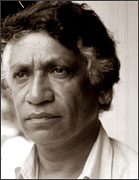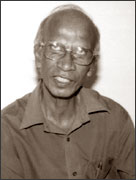Promoting the hide of literature and culture
Crisis-ridden Sri Lanka Arts Council:
Arts Council President Dharmasena Pathiraja was sacked by the
Minister of Cultural Affairs. Subsequently, President of the National
Drama Panel Thilak Jayaratne resigned in protest of the arbitrary
termination of service of Arts Council President Pathiraja, leading to
the resignation of Dr. Sumathi Sivamohan and Ruwanthie de Chickera in
protest.
Art and culture is not a static entity but dynamics that changes from
time to time assimilating confluence of diverse cultures and traditions
other than the indigenous literature and culture.
It is also true that literature and culture should, by and large,
reflect on the contemporary trends and aspirations of today's men and
women, especially of the youth.
 |
 |
| Dharmasena
Pathiraja |
Thilak
Jayaratne |
This universal truth seems to have conveniently been forgotten by
most of the officials in the Ministry of Cultural Affairs whose
understanding and attitude of art and culture is confined to
demonstration of 19th century adherents of some cultural features,
intrinsically associated with feudalism.
The Sri Lanka Arts Council (SLAC), which was established by an Act of
Parliament in 1952, consisted of several panels dedicated to fostering
diverse branches of art such as drama and literature. The Arts Council
is made up of the executive members and chairmen of the panels.
Though it had been established as far back as 1952, the objectives
and the activities of the Arts Council have not been changed to suit
modern-day requirements.
According to Dharmasena Pathiraja and Thilak Jayaratne, the role of
the Arts Council should be changed from being an arbitrary policing
agency which supervises and advices artist to an agency, which empowers
them.
They stated the blue-print for the broad-basing and socialisation of
the Arts Council was not to the liking of the officials, specially the
secretary to the Ministry of Cultural Affairs. Their idea of the Arts
Council seemed to be one which was similar to that of 'Cultural Police',
an obsolete idea rejected by the civilized world.
One of the proposals in the blue-print for the National Drama Panel
is the development of the John de Silva theatre into a fully-fledged
Training Centre and a theatre. Under the proposal it has also been
mentioned that such centres may set up at provincial levels. A Director
should be in charge of the Theatre. He or she should be given a
six-months or one year overseas training prior to the appointment.
One of the tasks that would be entrusted with the Director is to
direct dramas throughout the year and to create a highly evolved drama
culture by conducting workshops and educative programmes.
The Director should also be given a decent remuneration package to
maintain professional standards. In this respect, private sector
collaboration has also been mentioned.
As the Arts Council Act was drafted by Sir Ivor Jennings, the act
contains literal features.
For instance, in 1952, an annual grant in the sum of Rs. 250, 000, 00
had been set out in the budget. At present, however, the amount
channelled to the Arts Council was decided by the Ministry of Cultural
Affairs. Thilak Jayaratne pointed out that the British Arts Council
became independent from the British government during Margaret
Thatcher's regime.
British Parliament approved the amendment to the Arts Council Act's
and makes an annual grant to the British Arts Council which was utilised
to help the artists.
For instance, a group of young artists in Britain can hold a regional
drama festival with the sponsorship from the British Arts Council. He is
of the view that the Sri Lankan Arts Council should also be independent
so that it can assist artist rather than control and contain them. One
of the proposals was to make structural changes.
According to Thilak Jayaratne, the government cannot alone modernise
the John de Silva Theatre; private sector assistance should also be
obtained in this regard.
Dharmasena Pathiraja stated that the Minister of Cultural Affairs
Mahinda Yapa Abeywardene served him a letter of termination of his
service as the Chairman of the Arts Council as well as of being a member
of the Arts Council with immediate effect.
Acting on the powers vested on him by the Lanka Arts Council Act no
47 of 1988 (Amended) and Lanka Paragraph 9 (A) of the Arts Council Act
no 18 of 1952, the Minister has issued the letter of Termination dated
January 18, 2008.
Explaining the legal position of the Sri Lanka Arts Council,
Dharmasen stated that earlier the subject of the SLAC was vested with
the Ministry of Education. From the assumption of duties in the office
on December 23, 2005 to the day the letter of Termination was served on
him, Dharmasena had issues to iron out with the Ministry and the
Department.
The issues were on finding ways and means of democratizing the
structure of the SLAC and liberating it from the influence of the
Ministry of Cultural Affairs. The attempt to make SLAC an independent
body was made with the assistance of the Executive Committee.
Dharmasena argues that when the Soulbury Constitution was drafted in
the period of transition from Feudalism to Democracy, it envisioned the
importance of freedom of expression and the preservation of traditional
art forms.
Therefore, at the inception in 1952, SLAC was established as
democratic structure. For four years SLAC functioned as an independent
structure though it was under the preview of the Ministry of Education.
However, the independent nature of the SLAC changed in 1956 with the
establishment of the Ministry of Cultural Affairs. Since then on, SLAC
began to get politicised with the functions of the SLAC being taken over
by the Ministry. Dharmasena believes that the bureaucracy stills
entertain feudal attitudes towards arts and culture.
Former Chairman Bandula Jayewardene wrote a book titled 'History of
the Sri Lanka Art Council'.
He has clearly stated that former Ministers and Secretaries of the
Department of Culture had attempted to make SLAC pone.
Secretary to the Ministry of Cultural Affairs was reported to have
said that SLAC should be done way with.
The idea was not new which was tried to put into practice by Nissanka
Wijeratne, one time Secretary to the Ministry of Cultural Affairs. He
tried to set up a Cultural Board with the Minister as the Chairman to
dissolve the SLAC.
Once again an attempt was made to do away with the SLAC during the
tenure of Prof. A.V. Suraweera as the Deputy Minister of Cultural
Affairs. In terms of the SLAC Act, an annual allocation of three million
rupee for the SLAC is made, which is also barely sufficient to pay for
the members of 13 odd panels.
This accounts for sixty per cent of the allocations. Dharmasena
Pathiraja states that those panels, for the last four years, have acted
contrary to the objectives set out in the Act. They are more or less,
confined to conducting ceremonies.
One of the salient characteristics of the panels was that they were
divided on linguistic lines with no clear vision. For instance, there
are three drama panels; Sinhalese Drama Panel, English Drama Panel and
Tamil Drama Panel.
They could not work together. During his tenure, Dharmasena Pathiraja
reduced the panels from 13 to 5 and the number of panellists were
confined to 13 for each panel. The panellists represent all ethinicities
and the chairmen were instructed to work in three languages.
According to Pathiraja, one of his initial duties was to send a
letter to the Secretary of the Ministry of Cultural Affairs, requesting
him to define the duties entrusted with the SLAC which was blatantly
ignored by the Secretary and so far no reply was received. Dharmasena
pointed out that the Sahitya Kala Mahautsavaya (The great literary and
cultural festival) which was held in Anuradhapura had every component of
a festival sans literature.
SLAC had not been informed of the event. The festival consisted of
diverse pageants, literary hermitage with kavum, kokis and herbal
porridge being served to the visitor. According to Dharmasena, still the
Ministry officials held the notion that literature and culture is one
entity.
Though it is like a two sides of a coin, it is not the one and the
same. It is a pity that the Secretary of the Ministry of Cultural
Affairs identified the culture with pageants and partaking of
traditional cookies such as Halapa.
For instance, even at an evening meeting at 3.00 p.m. at the Ministry
of Cultural Affairs, they serve Kiribath (milk rice), kavum and banana.
A rather hilarious item was the Pageant of Values which paraded along
the street from Matara to Anuradhapura. It is still unknown as to what
happened to the large sum of money wasted on this and the leaflets
published for the purpose.
The leaflets were learnt to have been dumped into the gushing waters
of Malatu Oya, perhaps with the values engraved in them.
The Ministry also published a book of Merits (Pin Potha) at the
Government Press with thirty odd numbered blank papers to be filled by
the possessor with the daily entry of merits, in order of its
importance.
The book which was published by the Ministry of Cultural Affairs
contains verses extolling the triple gem (Thunsarane Gata).
A large number of books published and no one knows whether they were
distributed among the public.
The literary festival held in Horana had also been a grand
performance. However, SLAC had organised a two-day workshop for teachers
and students.
It seems that most of the officials' understanding of art and culture
confined to feudal festivals, totally ignoring the vast changes took
place over the years in the spheres of contemporary Sri Lankan culture
in general and youth culture in particular. |
